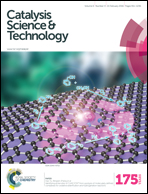Copper nanoparticles decorated polyaniline–zeolite nanocomposite for the nanomolar simultaneous detection of hydrazine and phenylhydrazine†
Abstract
In this study, a highly dispersed copper nanoparticles decorated polyaniline-nanocrystalline zeolite organic–inorganic hybrid material was synthesized. The hybrid material was characterized by the complementary combination of X-ray diffraction, N2-adsorption, scanning-transmission electron microscopy, Fourier transform infrared spectroscopy, and thermogravimetric techniques. An electrochemical sensor based on the copper nanoparticles supported polyaniline-nanocrystalline zeolite was developed for the nanomolar simultaneous detection of the environmental pollutants hydrazine and phenylhydrazine with high electrocatalytic activity, stability, sensitivity, and selectivity. Under the optimum conditions, a wide linear range was obtained from 4 nM-800 μM with a limit of detection of 1 nM for both hydrazine and phenylhydrazine. The analytical performance of the developed sensor was demonstrated for the determination of hydrazine and phenylhydrazine in different water bodies with satisfactory results.



 Please wait while we load your content...
Please wait while we load your content...